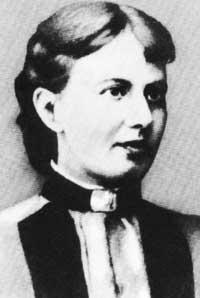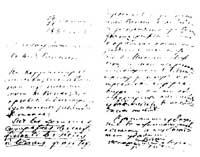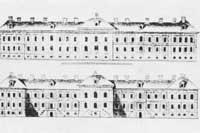Women Math
XX. Until the beginning of the 20th century, among the mathematicians who took part in the Mathematics building, few women appear. Among mathematical women are: Hypatia (?-415) Greek, who brought resurrection on classical mathematics; Emilie Marquise du Châtelet (1706-1749), French, founder of the texts of Newton and Leibniz; Emilie Maria Gaetana Gusta (1718-1799), Italian chair of science Vasphia These women are known because they have highlighted their work. It must be said, however, that in this and other areas there may not be so much relevance, but that many women who have done great work do not appear in history.

The causes of this situation were the conditions in the evolution of society, which basically determined the economic situation, the degree of knowledge, the prejudices, the religious decisions, the constitutions and the systems of government. Under capitalist systems, their ideological consequences made us think that women, especially in Mathematics and Nature Sciences, were more rebellious than men and that they were not so productive.
The assessment of women's intellectual capacity claimed that bourgeois ideology was unable to study. In Germany, for example, many universities and similar high-level institutions remained closed to women who remained closed until the middle of the last century. They were approved in the Universities and Higher Schools from 1870, yes, as listeners and without registration. From 1890 they were able to enroll as a full student. But in 1902 the Academic Council of the University of Berlin did not accept tuition and in Prussia, until 1908 admission had not been regulated. However, some courses offered the Minister of Education the possibility of prohibiting women's access. This case, that of scientists, is just one example of the difficulties that women have had in society. We must not forget those who have had in other areas of life.
Sonia Vasilievna was born on 3 January 1850 in Moscow. According to customs, Sonia and her sister studied at home with institutors. Both women dealt with intellectual activities. While Sonia was attracted by mathematics, her sister was linked to Literature.
His passion for mathematics was due to an uncle who transmitted him all the mathematical discoveries he had. One day he realized that the walls of the children's room were covered with sheets with mathematical calculations, since the wallpapers from Moscow did not arrive in time. They were written by his uncle about differential calculus and Sonia began to analyze it enthusiastically.
He later excelled in St. Petersburg Mathematics, so he decided to continue his studies in Mathematics, despite his father's opposition. Meanwhile, the young aristocracy and the Russian bourgeoisie began to demand a freer education (and women, above all, their own intellectual activity). Unable to pursue higher education in Russia, they tried to go abroad. But that was also difficult and many times convenience marriages were celebrated.
At the age of 17, Sonia, her sister and a friend, proposed to a classmate (Vladimir Onufriyevitx Kovalevsky) to marry and chose Sonia. After overcoming all obstacles, Sonia and Vladimir married at 18. After a year and a half in St. Petersburg, they went to study in Heidelberg. There they had a domestic life. Sonia left for Berlin in late 1870. Her husband, meanwhile, studied geology in Jena and Munich. As in convenience marriages it was quite frequent, with this distribution Sonia wanted to overcome the avatars she had with her husband.
He was prevented from entering all the universities in Berlin. That is why he turned to professor Karl Weierstrass. Aware of the ability of Weierstrass Sonia, despite being contrary to the incorporation of women to university, she receives it twice a week for consultations and helps her study.

In 1871 he made two trips to Paris to see and accompany his sister. A friend of his sister was imprisoned after the bath and sentenced to death. In a letter he wrote to his father to inform him of the situation then he said:
We were so fascinated by these new ideas, so convinced that the menerador social order would not endure much, that we believed that we had in our hands the era of freedom and universal enlightenment. We dreamed it was close and the arrival was safe.
In his studies Weierstrass initially worked on the works and methods he presented. Shortly thereafter he got to know enough to present his investigations. He wrote three papers: the first, on the theory of differential equations in partial derivatives, which allowed to answer some of the questions that until then were open; the second, referring to the structure of the Saturn ring; the third, explained the conditions of the rational functions of the four quadrimagic lines (of different zero (x,Q(x)))), the function F x and the rational function of Q(x).
Weierstrass himself called these works that he would not have any impediment to accept each work as a doctoral thesis and added: “But, as it is the first time a woman wants to get a doctorate in mathematical works, the Faculty, in addition to having reasons to establish rigid conditions, is in favor of my favorite interests... But as for the mathematical preparation of Mrs. Kovalevskiy, I can assure you that I have had few students comparable to her in terms of understanding, proper opinion, effort and calls for science.”
The first work was recognized as a doctoral thesis at the Faculty of Philosophy of the University of Göttingen, freeing itself from a hard examination for the doctorate. In 1874, therefore, he was given the title of doctor “in the absence of him”. The written request to the Dean indicated the following:
Before unknown men, the situation of the routine that I would force myself to respond jams me and confuses me. To this he added: I do not master German well to speak, although I think and write in Mathematics. My lack of ability to express myself in German is because five years ago I began to study and in four of them life in Berlin was domestic.
In the following years her work was affected by family circumstances (death of her father, suicide of her husband, birth of her daughter,...). The refraction of light in the glazed areas worked on issues related to the structure and integral abelines of the Saturn ring. His objective was not to enrich the Physical Sciences, but the acquired knowledge wanted to demonstrate it rigidly and mathematically. In 1881 the University of Stockholm offered him the chair.
The admission of the chair was delayed and until 1883 did not go to Stockholm. He then wrote to the Rector of the University:
I thank the University of Stockholm, the only European University that has opened its doors to me.

In order to understand perfectly what the chair announced, it must be borne in mind that the University of Berlin could not be accessed as an listener.
He published a selection of works from Stockholm. The rotation of a heavy solid around a fixed point earned him the Bordin Award from the Paris Academy of Sciences, the highest award given to a woman who received Christmas Day in 1888. The importance of the work consisted in considering time as a complex variable.
In 1890 he was elected to the Petersburg Academy of Sciences.
In addition to scientific work, Sonia devoted herself to letters. He wrote childhood memories. He finished a novel entitled “Catedrático no titular”. He also wrote poems and journalistic articles. She took on social problems and fought for women's rights. In his opinion:
I am considered pioneers in the women's emancipation movement in Stockholm.
In January 1891, when he returned from Italy to Stockholm, a great hoarseness surprised him. At first he did not pay much attention, but his situation worsened and on January 29 he died at the age of 41. In the legacy were the investigations initiated in Mathematics. Newspapers and magazines praised his scientific work and social activity. Stockholm cemetery was covered with flowers.
Buletina
Bidali zure helbide elektronikoa eta jaso asteroko buletina zure sarrera-ontzian











